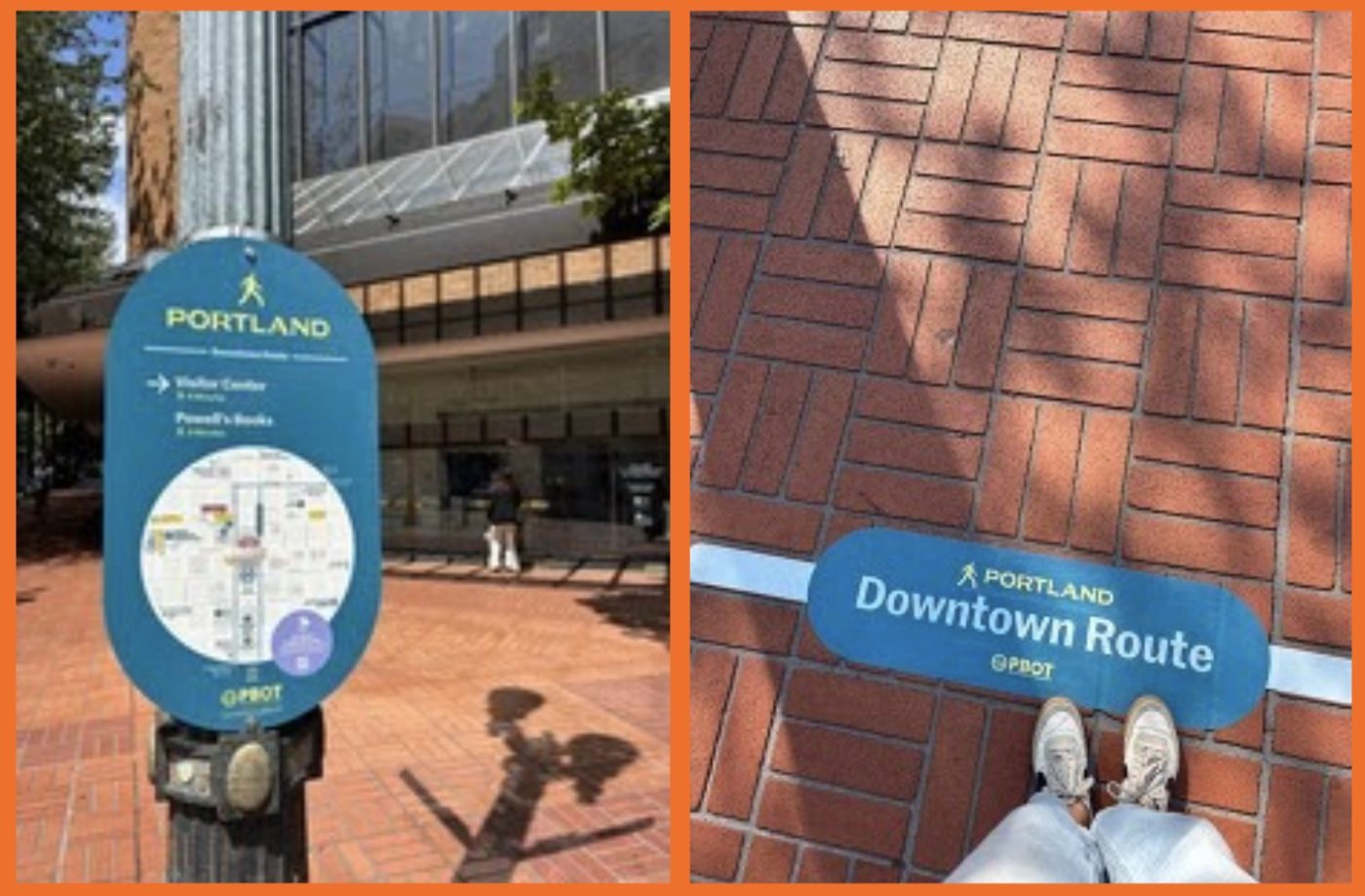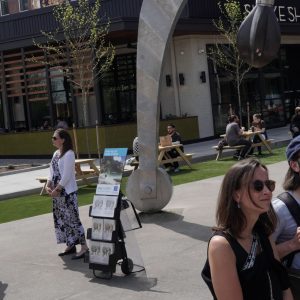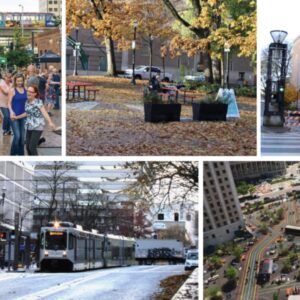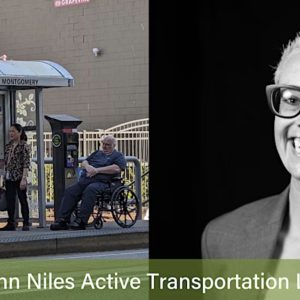There’s often backlash whenever we talk about spending money on marketing instead of infrastructure. But sometimes you just need to show people that something exists (a.k.a. marketing), and then try and persuade them to do it. When it comes to downtown Portland, contrary to all the haters and false narratives, it really is a great place to walk. It’s not that big and we’ve got nice things to see, awesome events going on (especially in summer) with cool shops and food destinations all over.
So I’m pretty optimistic about the joint pedestrian wayfinding effort from nonprofit Oregon Walks, Travel Portland and the Bureau of Transportation (PBOT). Officially launched the first week of August, this $150,000 project (and please don’t tell me how many crosswalks they could have built with that because the funding comes from a tourism-related grant), is a bunch of signs and markings that help folks get around downtown without a car. There’s also a companion website that lists events and shops along the route.
It’s called “Walk Portland” and it’ll be a three-month pilot that will run through the end of October. It’s a pilot and yet another effort to increase foot traffic in the downtown core. After the three months is up, professional planners and marketing folks will get together to assess what they’ve learned, combine it with public feedback, and design a future permanent wayfinding system
The Walk Portland route goes between Salmon Street Springs on SW Naito to Powells Books on NW Couch. They’ve chosen the SW Yamhill/SW Morrison couplet to take folks between SW 2nd and SW 10th. The route also utilizes SW Harvey Milk Street.
Oregon Walks Executive Director Zachary Lauritzen said the system will help people feel more confident — whether you’re new to town or have lived here your whole life. And Travel Portland President and CEO Megan Conway says it’s about being inclusive: “A place cannot be truly welcoming without being accessible and pedestrian-friendly.”
If you need an excuse to check out the cool new signs and markings, be sure to put the Downtown Sunday Parkways on your calendar for September 14th — part of the route intersects with the Walk Portland route.
And tomorrow night (Tuesday, August 19th), PBOT Pedestrian Advisory Committee will meet in person for a walking tour of the system. Everyone is welcome to join them. If you’d like to hear about the Walk Portland initiative from city planners and other smart folks, meet at 6:00 pm at the southwest corner of Pioneer Courthouse Square. The plan is to do a one-mile walking route that will, “allow participants to see all of the different interventions for the pilot, including both directional (small) and orientation (large) signs, nudge signs, sidewalk decals, and viny storefront window coverings.”
If you can’t make Tuesday’s night walk (where you can share feedback directly with city staff), be sure to take the survey after you’ve taken a closer look. Feedback is really important on things like this, because it’s being done specifically to see how people respond to it.
For more info on the project, check out WalkPDX.com.









Thanks for reading.
BikePortland has served this community with independent community journalism since 2005. We rely on subscriptions from readers like you to survive. Your financial support is vital in keeping this valuable resource alive and well.
Please subscribe today to strengthen and expand our work.
Interesting perspective you have.
Before Covid I walked down to the river and along the waterfront during my lunch break. That ended with the open air drug use and the woman who decided to go to the bathroom out in the open. Yeah, no more walks for me.
I had co-workers in the past assaulted on their walks through the Old Town neighborhood, again before Covid.
Now I daily go through Old Town from transit stop to office. It’s no picnic out there.
I know, right? Picnics are fraught with unpleasant things like mud, mosquitoes, ants and dog doings in and out of poop bags, all while you’re trying to eat! If you are lucky to get a picnic table, it’ll probably be soiled or splintery. I’m staying in my room and ordering out.
This is cool project. Walkability is critical to healthy, vibrant city, and good wayfinding is tricky. I hope this project brings some attention to PBOT’s egregious crosswalk closure at Morrison/Naito
https://maps.app.goo.gl/Csdc6AzU2KDQ1aE69
None of this means anything until the City of Portland and its citizens wake up and do what needs to be done. Even if that’s being “mean”.
Yep, that’s the problem with Portland. We just aren’t mean enough :/ if only we were more cruel and capricious to people you don’t want to see or interact with. That’d fix what ails our society
Well alright then don’t complain when you lose neighborhood by neighborhood to drug addicts. Many of us have already had where we live destroyed. It will come to YOU.
This is a dog megaphone.
I mean, if it seems to work, why not leave it up after 3-month trial?
This is nice and all, but the best way to encourage walking in downtown Portland would be to get rid of the open air drug use, and the squalor and lawlessness associated with unsanctioned camping.
Hello from Milwaukee. Thanks for boosting this pilot project, Jonathan.
Before I left for my trip, I did a long walk to and through downtown to check out the project. Here is an excerpt from my notes to PBOT and Oregon Walks:
“Last week (8/8), during a long walk to and through downtown, I had the chance to use your new wayfinding signs. They were clear, easy to follow, and genuinely helpful. Thank you! Along the way, I snapped photos of several signs as well as other PBOT-related sights, such as traffic diverters.”
I just completed the survey and am eager to see how the signage is received during the upcoming downtown Sunday Parkways. I might even casually ask people during my volunteer shift.
When I was in Milwaukee yesterday exploring the Historic Third Ward, I found the downtown wayfinding signs very helpful. Sure, I could’ve just used my smartphone (I retired from IT), but here are some reasons—courtesy of AI—why physical wayfinding signs can still be valuable:
1. Battery life – saves your phone battery.
2. Quick orientation – designed for pedestrians, easy to glance at without fiddling with a device.
3. Big-picture view – shows neighborhoods, landmarks, and walking distances in context, which is harder to see on a small screen.
4. Accessibility – not everyone has a smartphone, data coverage, or wants to use one all the time.
5. Reliability – no risk of losing GPS signal, Wi-Fi, or cell service.
6. Shared reference – groups can orient together without passing a phone around.
7. Place-making – highlights local history, culture, or attractions that apps often miss.
8. Reduced distraction – keeps your eyes up in the environment instead of glued to a screen.
9. Safety – less chance of wandering into traffic while staring at a phone.
If there are enough compelling destinations downtown, more people will walk there, wayfinding or no.
I was in Victoria last year, and there were interesting destinations all over (for both the tourist and non-tourist). Lots of people were walking around (but I saw very few people riding bikes). Also lots of drugs and zero tents.
Outside of the city center I found endless sprawl.
I was in Victoria in June, and saw a good amount of locals biking downtown, and in Fernwood. The bike lanes downtown are really good, and the drivers in the inner neighborhoods are really conscientious toward pedestrians and bicyclists!
I agree 100% that compelling destinations are important. There are a lot of empty storefronts downtown, even now, and I wonder if landlords are not being realistic with their rental rates. Right now, downtown should be an incubator for new/experimental businesses, and it’s just not taking the opportunity. I work downtown, but I’m never there on the weekends.
Agreed — Victoria drivers are very good as far as pedestrians go.
Landlords don’t always have the flexibility to lower their rent — if they have a loan on the building, that loan is tied to the value of the building, which is in turn controlled by the theoretical rental income the building will bring. Lowering the rent means lowering the building’s value, which could cause the bank to call back their loan, which could mean a need for the landlord to come up with a large amount of money quickly. If the building remains vacant, that’s bad for the landlord (no income), but not nearly as bad as a loan recall.
It’s kind of screwed up, but that’s my understanding of how it works. If you own the building outright, you’ve got a lot more flexibility to work with a tenant on the rent. The same holds true for residential properties.
Of course, I get that building owners are at the mercy of their mortgages. I just wish they would get out of the trap of finding tenants who only cater to the 8-5 work lunch crowds, and bring in something like this: https://www.nytimes.com/2025/08/18/realestate/art-workshops-companies-new-york.html
I would 100% stick around downtown in the evening if there was something cool like an art bar, or a pottery studio, or a craft-hangout-spot that had supplies and experts available to guide. These are lower-overhead, community-building businesses that give people a reason to hang out, patronize other businesses around them, etc.
An art studio might give a lunch-only restaurant a reason to stay open later into the evening, and it might be a great anchor to this walking route. Give people a destination that is not just buying books or buying a meal, but something to do.
I fundamentally agree with your take on the way the business/cultural ecosystem works.
“the trap of finding tenants who only cater to the 8-5 work lunch crowds”
How confident are you that there are potential tenants like this that want to be downtown?
Neighborhoods (like downtown) go through cycles. Right now things are tough, but are likely to rebound at some point, as it has in the past, especially if the city can get control of the social dysfunction that plagues the area. Victoria shows total elimination is not required to restore vitality, but current conditions in Portland are not good.
Seems like a super cool project & hope it promotes walking. BUT I have to note the irony: the location by Salmon springs (featured pic) is suffering from a tourist bus problem. Last week saw tour bus parked IN the Better Naito bike lane unloading passengers, then bus drove a ways IN bike lane before it used Salmon Springs gap in the curb to pulled back out onto Naito. Also recently saw a big tour bus parked in the park right next to the fountain! Bus then drove in a big circle around the fountain to find a way to get back out of the park (not all cement is for driving). We might need wayfinding for tour busses: maybe couple of unloading spots on nearby blocks and directions for tour bus drivers where to park. Otherwise the pedestrian way finding wont matter when Salmon Springs becomes parking lot for tour bus tourists.
That was designed with bollards to keep cars and busses out- those have all disappeared. PBOT needs to re-install all the bollards. My previous commute went through here 2X daily and Uber/Lyft is a consistent problem there
Portland used to have these kind of wayfinding signs all over the core. One problem I remember was keeping them up-to-date as various landmarks opened or went away.
Here’s what the old signs looked like.
The designer’s website says they were installed in 2007. I don’t remember when they went away.
I applaud the intent, but no amount of signage will make walking and socializing downtown more appealing unless/until we claw back a significant amount of the space we’ve ceded to motor vehicles. It’s hard to have a vibrant, pleasant downtown with rivers of big, loud, exhaust-spewing cars and trucks flowing in every direction, between banks of stationery cars and trucks. Particularly when so many drivers of those vehicles are impatient, distracted, and/or flat-out hostile.
Portland has had one before, perhaps several times, with cars present in each. Other cities have vibrant downtowns with plenty of car traffic. NW 21st & 23rd are about as car-clogged as it gets, and they are pretty vibrant, as is Hawthorne.
Downtown Portland is in slump right now, for sure, but I don’t think many would agree that the problem is too many people driving there.
You’re right—it’s not THE problem. But who can argue it’s not a big impediment?
More cars and trucks = More noise, more exhaust and fumes, more danger for pedestrians and cyclists … and less space, overall, for anyone not in a car or truck.
Fewer cars and trucks = Less noise, cleaner air, less danger for pedestrians and cyclists … and more space, overall, for anyone not in a car or truck.
The fact that certain streets or neighborhoods are “vibrant” despite being car-clogged ignores the obvious question of how much more pleasant and inviting they’d be with fewer cars.
Some cities, at last, are catching on to this by taking deliberate steps to reduce traffic, with predictably good results. Paris and NYC leap to mind.
tl;dr: You don’t need to choke a city with cars and trucks to make it unpleasant … but it sure helps.
They built a damn shelter near PSU yet the area is still severely plagued with tramp vagrant tent camps. Not very pedestrian friendly.
Just to share my experience…
I have a friend who lived in Los Angeles (Koreatown) for a number of years & now lives up in Clallam County, WA area, as well as a friend who lives in Germany, in town last Saturday (13th) to visit. We walked from the Japanese Garden down to Flanders, up NW 23rd Ave a bit, and back to Flanders again then headed down to Powell’s Books. We walked for a few hours, a little under 6 miles. They both commented on how clean the city was, how there was barely any litter, how it didn’t smell like piss. There were street fairs with live music. People playing music and singing Lord of the Rings-themed songs in the international rose test garden. We had no unpleasant interactions with anyone.
Would walk again.